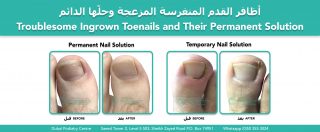Troublesome Ingrown Toenails and Their Permanent Solution
Troublesome Ingrown Toenails and Their Permanent Solution
By Michelle Champlin, Chief Podiatrist – Dubai Podiatry Centre
Troublesome ingrown toenails that require professional trimming can lead to infection and a great deal of pain if left untreated. Fortunately, there is a permanent solution available through podiatric care.
Why Ingrown Toenails Develop
In some patients, the toenail itself has structural features that make it prone to ingrowth. For example, when the nail plate is too wide for the width of the toe, much like overcrowded teeth in a small jaw, there simply isn’t enough space for it to fit properly.
A toenail that is flat and fan-shaped, widening towards the tip of the toe, often causes severe ingrown toenails. Similarly, when the nail collapses inward and becomes involuted, the edges dig into the surrounding skin, creating intense pinching and pressure.
When Trimming Isn’t Enough
Although corrective trimming and regular medical pedicures can help, they may not resolve the problem completely. Because the nail continues to grow in the same distorted shape from its root, professional trimming offers only temporary relief. In persistent cases, a minor surgical procedure called a Partial Nail Avulsion provides a long-term solution.
Partial Nail Avulsion Explained
This procedure is performed under local anaesthetic, specifically formulated for use in the toes. Unlike dental anaesthetics, which contain adrenaline to reduce blood flow, podiatrists use plain anaesthetic solutions without vasoconstrictors to preserve circulation. Maintaining blood flow is essential, as restricting it for too long can cause tissue necrosis.
To control bleeding during the short treatment period, a tourniquet is gently applied to the toe, making the area temporarily pale and bloodless. This ensures a clear field for the procedure. The podiatrist then removes the ingrown portion of the nail while leaving the healthy nail intact.

Preventing Regrowth
If the removed nail section is not treated, it will simply grow back in the same way. To prevent recurrence, the podiatrist applies a chemical called phenol to the exposed nail root and matrix, a process known as phenolization.
Phenol chemically cauterizes the nail root, preventing regrowth while minimizing scarring. Surgical removal of the nail root, by contrast, can result in scarring and, over time, may still allow regrowth.
Healing and Aftercare
Phenolization causes a mild chemical burn, leading to a temporary inflammatory reaction called a phenol flare and some sticky exudate from the healing tissues. This is normal.
The risk of infection is extremely low when post-operative care instructions are followed. Podiatrists provide sterile dressings, antiseptic solutions, and close follow-up to ensure healthy tissue repair.
Scope of Practice and Expertise
Partial and total nail avulsion procedures are considered the gold standard for treating chronic ingrown toenails. Podiatrists perform these procedures routinely and are specifically trained for them within their professional scope of practice.
In the United Arab Emirates, the Department of Health and Ministry of Health explicitly include these procedures within the podiatrist’s scope of practice, ensuring that patients receive safe, regulated, and expert care.
For more information or to book an appointment please call our clinic +971 4 3435390 or WhatsApp +971 50 3553024

